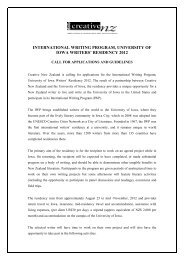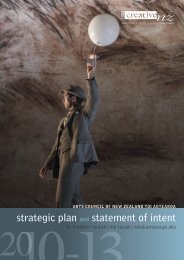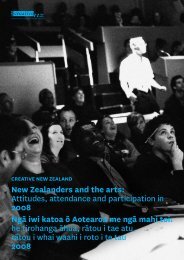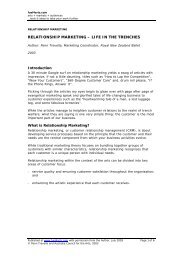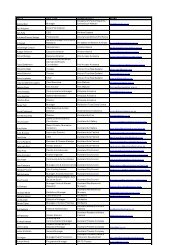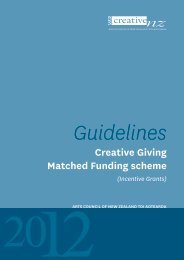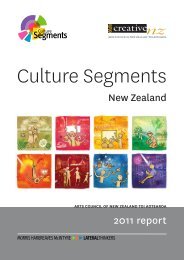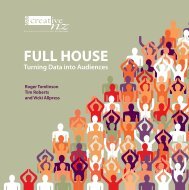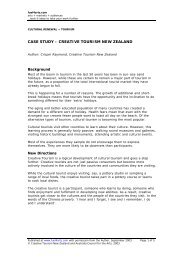Download PDF 626 KB - Creative New Zealand
Download PDF 626 KB - Creative New Zealand
Download PDF 626 KB - Creative New Zealand
You also want an ePaper? Increase the reach of your titles
YUMPU automatically turns print PDFs into web optimized ePapers that Google loves.
Panellists: Aidan Lang, NBR <strong>New</strong> <strong>Zealand</strong> Opera – Carla Theunnisen, Q Theatre – James<br />
McCarthy, Te Tuhi Arts Centre – John Smythe, Theatreview<br />
With a question as long as that, this discussion was bound to throw up conflicting ideas. The<br />
following is a summary of panellists’ and audience thoughts:<br />
• What level of passivity are we talking about? Some art forms don’t readily lend<br />
themselves to moving beyond the proscenium arch in performance – but does that<br />
mean audiences are passive? They have taken a very active step in purchasing<br />
tickets. Some forms of theatre are very [overtly] interactive – e.g. pantomime,<br />
comedy.<br />
• Even in theatres where actors/musicians are on stage, the audience have always<br />
contributed – theatres are not darkened temples. Being present with actors and<br />
musicians creating a performance is not a passive experience – it has an<br />
extraordinary effect on people, far removed from hearing the same work on a CD.<br />
• Theatres will not be as relevant in the future as they are now. Technology is causing<br />
massive shifts in the way people partake in art. Making art is now more interactive<br />
and one-to-one. Companies will have a digital producer as well as a live one.<br />
• Often the people having the most fun in a theatre are the performers. <strong>New</strong> styles of<br />
performance can be emotive and powerful and put the audience in the performer’s<br />
seat. It’s difficult to be bored if you are interactively engaged.<br />
• It’s only in the 20 th century that we’ve put the “fourth wall” in performance venues and<br />
audiences have become passive absorbers of the performing arts.<br />
• “I don’t believe that sitting in a dark auditorium is passive if you are empathising,<br />
having thoughts, engaging with concepts of moral dilemma.” (John Smythe)<br />
• There is still room for the playwright-initiated work creatively developed by other<br />
people – that’s where the deep thinking happens. Tricky novelties will not engage<br />
audiences.<br />
• A youth audience needs stimulus in another way. This is a valid audience and should<br />
be provided for.<br />
• The shared theatrical experience generates a magical bond between audience and<br />
performers. And the tone of the performance can be completely changed according<br />
to the reaction of the audience.<br />
• Audience engagement doesn’t have to mean interactivity or co-creation. Immersion<br />
in an art experience can be still (as in a gallery) but not passive because your head is<br />
filled with ideas and meanings – one is taken to another time and place.<br />
• Social media is one aspect of using the internet to communicate about art. The<br />
internet is also used to engage people in making art. The challenge for arts<br />
organisations to think about is: Does engaging people interactively become an end in<br />
itself? How does it connect with your core business? Or are you seriously thinking of<br />
changing your practice?<br />
• Changing technologies have completely changed people’s expectations of how<br />
interpretation should be provided in galleries. They want to experience exhibitions.<br />
There is an assumption that all the “stuff” to read is online – they expect to go online<br />
before and after every visit.<br />
• Challenge: Are audience expectations (of digital engagement) going to race ahead of<br />
our staff structures?



